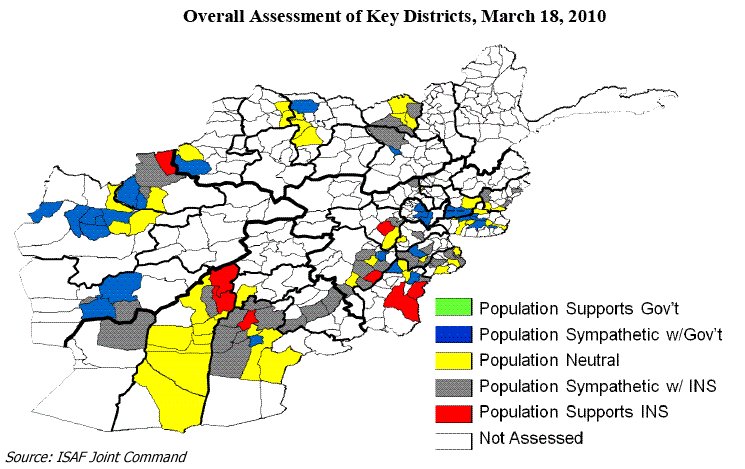
There’s been a lot of discussion lately about the level of #Taliban control in #Afghanistan, so this is a brief THREAD on that topic. 1/n
The debates about district control go back a long time. I was first involved in these during my time @CENTCOM circa 2009. At that time, ISAF was producing district control maps, as was CENTCOM & @DefenseIntel (among others). None of them agreed on methods or results. 2/n 

@CENTCOM @DefenseIntel Later, while with ISAF & at the command’s request, I wrote an internal memo laying out the challenges with the various methodologies involved with assessing "control" at the district level in #Afghanistan. 3/n
@CENTCOM @DefenseIntel Some of the more significant issues w/it entail: What does “control” really mean & how should it be characterized? What are the appropriate indicators & data sources for assessing it? Are districts the best (or even a meaningful) unit of measure for it? 4/n
@CENTCOM @DefenseIntel These Qs have never been fully resolved & so the discussion continues today. IMO, “control” is a fraught concept for a bunch of reasons. But its conceptual simplicity to lay audiences makes it nonetheless appealing & so it persists in popular forums. 5/n
https://twitter.com/JJSchroden/status/1413830568433827842?s=20
@CENTCOM @DefenseIntel This is where @billroggio comes in. The USG used to produce mult versions of control maps. But the USMIL stopped doing so several years ago (I describe why in this @WarOnTheRocks article). That left Roggio's map as the only long-standing game in town. 6/n
warontherocks.com/2019/05/milita…
warontherocks.com/2019/05/milita…
@CENTCOM @DefenseIntel @billroggio @WarOnTheRocks It’s a credit to @billroggio that he stuck w/it while others packed it in. While his maps suffer from the imperfections of the “control” concept as described above & limits of his sources/methods, the consistency of his work over time nonetheless provides something useful. 7/n
@CENTCOM @DefenseIntel @billroggio @WarOnTheRocks It's interesting now, however, to see a bunch of different control maps emerging again. Not surprising w/the #Taliban offensive + US withdrawal in the news, but interesting nonetheless. Here is one published by the BBC recently. It differs markedly from @billroggio's map. 8/n 

@CENTCOM @DefenseIntel @billroggio @WarOnTheRocks Here’s one that @mansfieldintinc posted yesterday. It’s much closer to @billroggio's than the @BBC map. 9/n
https://twitter.com/mansfieldintinc/status/1415335107238445059?s=20
@CENTCOM @DefenseIntel @billroggio @WarOnTheRocks @mansfieldintinc @BBC And here’s one that @AANafgh produced in a recent report. While showing change in control as opposed to current status, it nonetheless appears to comport more closely with @billroggio's map than the @BBC's. 10/n 

@CENTCOM @DefenseIntel @billroggio @WarOnTheRocks @mansfieldintinc @BBC @AANafgh The point of all this is: 1) “Control” is not a well-defined or consensus concept—different analysts/sources differ on what it means; 2) None of these maps should be viewed as precise—I would put a ROM estimate of +/- 10-15% error bars on control %s derived from any of them. 11/n
@CENTCOM @DefenseIntel @billroggio @WarOnTheRocks @mansfieldintinc @BBC @AANafgh Is it worth arguing over which is more accurate? No.
Better to look at the big picture: the mil balance between the #Taliban & #Afghanistan's govt is a lot closer to even than many people believed prior to the US withdrawal, as I discussed earlier. 12/n
Better to look at the big picture: the mil balance between the #Taliban & #Afghanistan's govt is a lot closer to even than many people believed prior to the US withdrawal, as I discussed earlier. 12/n
https://twitter.com/JJSchroden/status/1414679260200153089?s=20
@CENTCOM @DefenseIntel @billroggio @WarOnTheRocks @mansfieldintinc @BBC @AANafgh And no one should rely on or cite these maps uncritically—they’re all flawed/imprecise in their own ways. At best, they give a general sense of what’s happening in #Afghanistan (both currently & over time), not a precise measurement of it. 13/n
@CENTCOM @DefenseIntel @billroggio @WarOnTheRocks @mansfieldintinc @BBC @AANafgh Last point: the FY21 Nat'l Defense Authorization Act required #DOD to start producing district control maps again & to make them public. If/when the Pentagon complies w/that requirement, it'll be yet another map in the fray. 14/14
• • •
Missing some Tweet in this thread? You can try to
force a refresh



